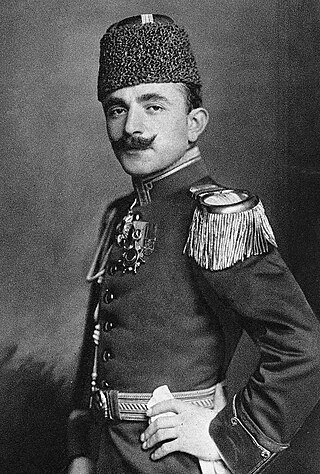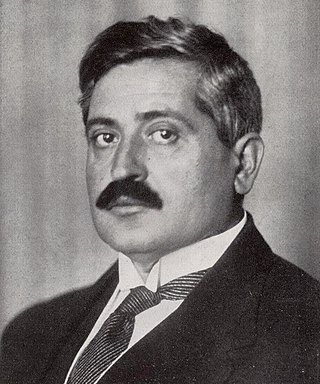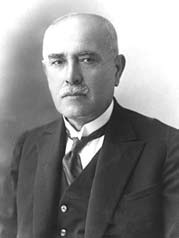
The Armenian genocide was the systematic destruction of the Armenian people and identity in the Ottoman Empire during World War I. Spearheaded by the ruling Committee of Union and Progress (CUP), it was implemented primarily through the mass murder of around one million Armenians during death marches to the Syrian Desert and the forced Islamization of others, primarily women and children.

The Young Turks was a broad opposition movement in the late Ottoman Empire agitating against Sultan Abdul Hamid II's absolutist regime. The most powerful organization of the movement, and the most conflated, was the Committee of Union and Progress (CUP), though its goals, strategies, and membership continuously morphed throughout Abdul Hamid's reign. By the 1890s, the Young Turks were mainly a loose and contentious network of intelligentsia exiled in Western Europe and Egypt that made a living by selling their newspapers to secret subscribers.

İsmail Enver, better known as Enver Pasha, was an Ottoman military officer, revolutionary, and convicted war criminal who formed one-third of the dictatorial triumvirate known as the "Three Pashas" in the Ottoman Empire.

Mehmed Talaat, commonly known as Talaat Pasha or Talat Pasha, was an Ottoman Young Turk activist, politician, and convicted war criminal who served as the de facto leader of the Ottoman Empire from 1913 to 1918. He was chairman of the Union and Progress Party, which operated a one-party dictatorship in the Empire; during World War I he became Grand Vizier. He has been called the architect of the Armenian genocide, and was responsible for other ethnic cleansings during his time as Minister of Interior Affairs.

Ahmed Djemal, also known as Djemal Pasha, was an Ottoman military leader and one of the Three Pashas that ruled the Ottoman Empire during World War I.
The Three Pashas, also known as the Young Turk triumvirate or CUP triumvirate, consisted of Mehmed Talaat Pasha, the Grand Vizier and Minister of the Interior; Ismail Enver Pasha, the Minister of War and Commander-in-Chief to the Sultan; and Ahmed Djemal Pasha, the Minister of the Navy and governor-general of Syria, who effectively ruled the Ottoman Empire after the 1913 Ottoman coup d'état and the subsequent assassination of Mahmud Shevket Pasha.
Djevdet Bey or Djevdet Tahir Belbez was an Ottoman Albanian governor of the Van vilayet of the Ottoman Empire during World War I and the Siege of Van. He is considered responsible for the massacres of Armenians in and around Van. Clarence Ussher, a witness to these events, reported that 55,000 Armenians were subsequently killed. Djevdet is also considered responsible for massacres of Assyrians in the same region.

Mehmet Cavit Bey, Mehmed Cavid Bey or Mehmed Djavid Bey was an Ottoman economist, newspaper editor and leading politician during the dissolution period of the Ottoman Empire. As a Young Turk and a member of the Committee of Union and Progress (CUP) had positions in government after the constitution was re-established. In the beginning of the Republican period, he was controversially executed for his alleged involvement in an assassination attempt against Mustafa Kemal Atatürk.
Hans-Lukas Kieser is a Swiss historian of the late Ottoman Empire and Turkey, Professor of modern history at the University of Zurich and president of the Research Foundation Switzerland-Turkey in Basel. He is an author of books and articles in several languages.

The Committee of Union and Progress, refers to several revolutionary groups and a political party active between 1889 and 1926 in the Ottoman Empire and the Republic of Turkey. The foremost faction of the Young Turks, the CUP instigated the 1908 Young Turk Revolution, which ended absolute monarchy and began the Second Constitutional Era. After an ideological transformation, from 1913 to 1918, the CUP ruled the empire as a dictatorship and committed genocides against the Armenian, Greek, and Assyrian peoples as part of a broader policy of ethnic erasure during the late Ottoman period. The CUP and its members have often been referred to as Young Turks, although the movement produced other political parties as well. Within the Ottoman Empire its members were known as İttihadcılar ('Unionists') or Komiteciler ('Committeemen').

Killing Orders: Talat Pasha's Telegrams and the Armenian Genocide is a 2016 book from Taner Akcam about the veracity of the primary source evidence of the Armenian genocide, particularly telegrams sent by Talaat Pasha. He addresses dismissal of the authenticity of evidence as a form of Armenian genocide denial. The original Turkish version was published in Istanbul by İletişim Yayınları. The English version, published by Palgrave Macmillan, came in 2018.
Ahmet Faik Erner (1879–1967) was an Ottoman Turkish bureaucrat and a member of the Committee for Union and Progress (CUP).

The relationship between the Armenian genocide and the Holocaust has been discussed by scholars. The majority of scholars believe that there is a direct causal relationship between the Armenian genocide and the Holocaust, however, some of them do not believe that there is a direct causal relationship between the two genocides.
National economy is the economic plan, essentially kleptocratic, envisioned by Ziya Gökalp and carried out by successive Ottoman and Turkish governments, which involved the systematic dispossession of native Christian upper-classes and their replacement by Muslim Turks, in addition to large-scale confiscation and redistribution of Christian-owned property. Türk Yurdu announced 1915 as the starting year of the national economy. To Emil Ludwig, Talaat Pasha mentioned that the loss of the Armenian workforce would damage the economy for a short while, but that Turks would step in their positions and replace the Armenians soon.

On 15 March 1921, Armenian student Soghomon Tehlirian assassinated Talaat Pasha—former grand vizier of the Ottoman Empire and the main architect of the Armenian genocide—in Berlin. At his trial, Tehlirian argued, "I have killed a man, but I am not a murderer"; the jury acquitted him.

Ali Münif Yeğenağa was an Ottoman politician and government minister, who played an active role in the Young Turk Revolution, he also served as the Minister of Education of the Ottoman Empire in 1918. He was furthermore a close friend of Talaat Pasha and played a prominent role in the Armenian genocide.

Differing views of what caused the Armenian genocide include explanations focusing on nationalism, religion, and wartime radicalization and continue to be debated among scholars. In the twenty-first century, focus has shifted to multicausal explanations. Most historians agree that the genocide was not premeditated before World War I, but the role of contingency, ideology, and long-term structural factors in causing the genocide continues to be discussed.

The state funeral of Talaat Pasha, former Grand Vizier of the Ottoman Empire and one of the chief architects of the Armenian genocide, took place at the Monument of Liberty in Istanbul, Turkey, on 25 February 1943. At the request of the office of the prime minister of Turkey, Şükrü Saracoğlu, Talaat's remains were disinterred and transported to Turkey. The funeral was attended by Prime Minister Saracoğlu, German ambassador to Turkey Franz von Papen, and Turkish journalist Ahmet Emin Yalman. With this gesture, Adolf Hitler hoped to secure Turkish support for the Axis in World War II. Hüseyin Cahit Yalçın gave the funeral oration as Talaat was buried at the monument, originally dedicated to those who lost their lives preventing the 1909 Ottoman countercoup.

The Said Halim Pasha cabinet was headed by Grand Vizier Said Halim Pasha. It was formed on 17 June 1913 after Mahmud Shevket Pasha's assassination. It soon came to be wholly controlled by the Union and Progress Party. With the exception of Mardikyan Bey being the only Christian, everyone in cabinet was Muslim, with Said Halim Pasha and his brother Abbas Pasha Arabs and the rest Turks.

Below is an outline of Wikipedia articles related to the Greek genocide and closely associated events and explanatory articles. The topical outline is accompanied by a chronological outline of events. References are provided for background and overview.














